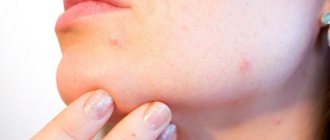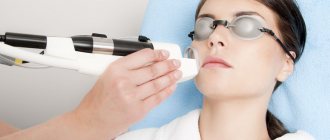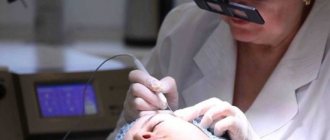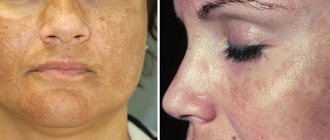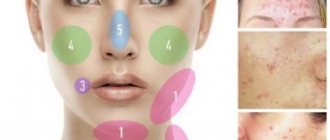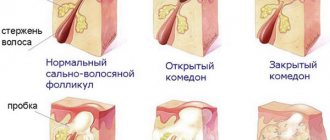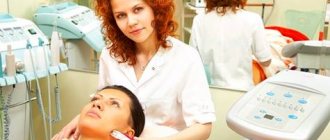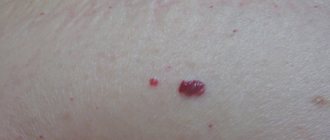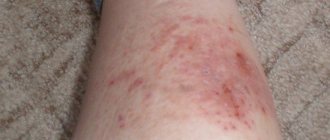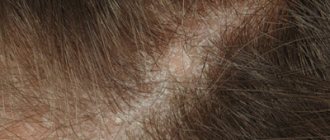Types of skin diseases, how they manifest themselves
Skin diseases localized on the surface of the face are acute or chronic pathologies that are characterized by damage to the dermis, fatty tissue, or epidermis. The disease may have a bacterial, viral, fungal, parasitic, chemical or thermal etiology.
They can affect large areas of the skin surface of the face, covering the scalp, or be localized to a point. Most dermatological diseases of this type are accompanied by an inflammatory process.
Types of skin diseases on the face
There are a small number of dermatological diseases that occur exclusively on the surface of the face. The table below provides detailed information about ailments of this type with a description of their clinical manifestations.
Acne is the most common skin disease on the face
| Type of disease | Characteristic |
| Acne | Expressed as acne. Red pimples appear on the patient's face and become inflamed. Purulent contents may accumulate inside the acne. |
| Rosacea | A chronic disease of the epithelial surface of the face, which is expressed in the expansion of small blood vessels, the appearance of swelling, redness, and pain. |
| Demodicosis | Damage to the skin by a parasite - the scabies mite. The epithelium becomes dry, itchy, and a small pink rash appears. Secondary infections may occur in areas where scratching occurs. |
| Flaming nevus | Areas of the facial dermis, the surface layer of which has overly dilated capillaries. The disease is characterized by the absence of an inflammatory process, or the manifestation of painful symptoms. |
| Rhinophyma | Chronic pathology of the epithelial tissues of the nose, which is characterized by the constant division of its cells. Ultimately, the organ acquires large sizes and becomes ugly in appearance. |
| Streptoderma | An infectious disease that manifests itself in the appearance of wound formations. From many small ulcers ichor oozes, they dry out for a while, and then become inflamed again. Without proper treatment, ulcerative formations quickly increase in diameter. |
| Allergic dermatitis | Acute or chronic skin irritation, which leads to the appearance of small rashes, itching, and scratching. Swelling may appear. |
In medical practice, there are clinical cases when the epidermis of the face is affected by dermatological diseases, the course of which is typical for other parts of the body.
When a facial abrasion can be dangerous
Any injury has degrees of severity, and an abrasion on the face is no exception. With a mild form of injury, pain and burning sensations appear at the wound site, droplets of blood and ichor appear on the surface of the wound, and slight swelling of the tissue around the abrasion appears. With such symptoms, damage to the skin can be easily dealt with on your own, but sometimes the situation is a little more serious. So, you should go see a doctor if the following points appear after being injured:
- For a long time it is impossible to stop the flow of blood or it flows heavily;
- Pus appears at the site of injury, the skin around the wound becomes hot and there is a general increase in body temperature;
- It is not possible to clean the abrasion on the face from contamination (dust, dirt, foreign small objects).
Bleeding that does not stop may indicate damage to large vessels. In this case, to stop blood loss, doctors resort to cauterization. If there is pus in the wound, this indicates that it is infected with microbes and bacteria. When pus appears, the use of healing ointments for abrasions and scratches alone will not be enough. Treatment is supplemented with drugs that have an antimicrobial and antibacterial effect. If the wound is heavily contaminated, then it must be thoroughly cleaned, otherwise this can lead to the same infection with all subsequent complications, as well as to the infection entering the bloodstream and spreading throughout the body.
Stages and degrees of skin diseases on the face
Skin diseases on the face have certain stages of development. Their classification depends on the severity of the disease and the clinical picture observed in the patient at the time of the diagnostic examination. The following stages of dermatological diseases are distinguished based on their varieties.
| Type of disease | Stages |
| Acne | 1 – small acne appears. 2 – the rashes acquire a rich red and sometimes purple hue and become painful. 3 – pimples fill with purulent contents, noticeably increase in size, cover most of the surface of the cheeks, temples, frontal lobe of the head and triangle of the nose, causing swelling. |
| Rosacea | 1 – a localized red spot appears on the face, upon examination of which it is clear that its nature of origin is associated with dilated blood vessels. 2 – the shade of the epithelial cover becomes more saturated, and the translucency of the capillaries is more pronounced. 3 – swelling and soreness of the affected area of the face occurs, which can only be relieved with the help of drug therapy. |
| Demodicosis | 1 – the epithelial cover becomes covered with a barely noticeable pink rash. 2 – the affected area begins to itch very much, which is especially noticeable at night. 3 – the skin turns red, dries out, begins to peel, and scratching may occur. |
| Flaming nevus | A hereditary disease of the epithelial surface of the face and scalp, which in 98% of cases retains the same size, color shade and other characteristics without changing stages. |
| Rhinophyma | 1 – the patient observes minor physiological changes in the size of the nose, which do not cause any pain. 2 – accelerated division of epithelial cells occurs, the body of the nose, with the exception of bone tissue, rapidly increases, and the process of excessive growth of the organ itself is uncontrolled. 3 – the nose reaches an abnormally large size, outwardly resembling a foreign tumor neoplasm, which most often has a benign nature of origin. |
| Streptoderma | 1 – 1 to 3 small wounds are observed on the skin surface, which are initially formed by a streptococcal infection. 2 – ulcers rapidly increase in size, itch very much, become not only wide in diameter, but also deepen into the soft tissues of the face. 3 – there is abundant insemination of the skin with streptococcal infection, there are multiple wounds that itch, and ichor is constantly released from them, forming a dense yellow crust. |
| Allergic dermatitis | 1 – redness of the epidermis of the face appears in areas that have been in contact with a potential allergen. 2 – irritated skin itches, scratching occurs, and a small red rash appears. 3 – the concentration of allergens in the patient’s body and the upper layer of the epithelium reaches peak values, which is expressed in the constantly present itching of the skin, swelling, rash, and red spots. |
The rate of transition of the disease from one to another stage depends on individual factors such as the patient’s immune status, the quality of his diet, working conditions, age, genetic predisposition to dermatological diseases, as well as the presence or absence of drug therapy for the disease.
Causes of skin diseases on the face
Skin diseases on the face cannot appear without good reason. For the most part, these are the results of prolonged exposure to negative factors that systematically irritate the epithelial cover, reduce its protective function and ultimately lead to the manifestation of the first symptoms of the disease.
Only diseases of hereditary etiology arise suddenly, as well as those that arose as a result of infection of the epidermis with severe forms of viral or bacterial infection (skin tuberculosis, Staphylococcus aureus, streptococcus, anthrax).
The following causes of painful skin conditions are identified:
- imbalance of male and female sex hormones, which often causes acne in adolescents;
- the use of low-quality cosmetics, the components of which irritate the epithelium;
- unbalanced diet, consumption of food low in vitamins and minerals;
- hereditary tendency to develop facial skin diseases;
- nervous overstrain, constant stressful situations, which can ultimately lead to the development of psoriasis;
- unsatisfactory environmental conditions, daily contact of the epidermis with vapors of chemical compounds, dust, particles of dirt;
- allergic reaction to external environmental irritants;
- infection of the epithelial cover by pathogenic microorganisms (viruses, infections, parasites, fungal spores).
Determining the cause of the development of a dermatological disease of the face is the main condition for successful therapy. Otherwise, the occurrence of a relapse of the disease after complete recovery cannot be ruled out.
Diagnosis of skin diseases on the face
Skin diseases on the face can be diagnosed in a district hospital at the patient’s primary place of residence, or in a private clinic. The patient independently determines the medical institution that will deal with his examination and further treatment.
To determine a dermatological disease of the face, you will need to undergo the following types of tests:
- blood from a vein - the hormonal background of the body is determined, the presence or absence of infectious microorganisms that can affect the skin (test cost - 1000 rubles);
- general urine analysis - the basic indicators of the biochemical composition of urine are determined (the average cost of the examination is 450 rubles);
- blood from finger – a clinical analysis of its main components is performed, the glucose level is identified (the cost of the examination is 500 rubles);
- a smear from the surface of the skin in the area of its lesion is transferred to the laboratory department, where specialists, using instrumental and biochemical methods, determine the nature of the origin of the disease (price - 800 rubles);
- biopsy is a study of epithelial particles that have been changed under the influence of pathogenic factors or infectious microorganisms (cost about 2000 rubles).
If the doctor diagnosing the patient suspects the presence of a genetic disease, a venous blood test may be prescribed for a screening test. In this case, doctors determine whether the patient has a hereditary predisposition to a specific disease. The average cost of a medical service is 5,000 rubles.
Prevention of skin diseases on the face
It is possible to prevent the occurrence of dermatological diseases of the face, but for this it is necessary to follow simple rules of prevention daily, consisting of the following aspects:
- stop drinking alcohol, smoking and taking drugs;
- use only high-quality and certified facial cosmetics, or completely minimize its use;
- Wash your face every morning and evening with warm water and hypoallergenic soap;
- in case of excessive dry skin, use natural-based moisturizing creams;
- balance the diet, saturating it with fresh vegetables, herbs, fruits, ocean fish, chicken, rabbit, veal, eggs, cereals;
- avoid overcooling the skin of the face or exposing it to fumes of chemicals (acids, alkalis);
- promptly begin treatment of foci of infection in the body (especially if they have a chronic course).
The only dermatological diseases that are not affected by preventive measures are those that have a hereditary etiology. Most ailments of this type are diagnosed in a person from the first days after his birth, or arise at a certain stage of life when the pathological gene manifests itself.
The concept of acne: why they appear
First you need to understand that pimples never appear just like that. This is a sign of some kind of problem in the body. For example, from the age of 10 or 12, the so-called period of growing up begins. It is during adolescence that most young people first encounter the problem of acne on the forehead. This occurs due to a surge in hormones; a similar situation occurs during menstruation, pregnancy and after childbirth.
Small pimples on the forehead, scattered, mean problems with the genitourinary system. Sometimes, inflammation and craters on the forehead appear from bangs (especially in summer), more precisely due to the fact that the skin is poorly ventilated and sweats. If the pimples itch, then this is definitely an allergy; their treatment requires consultation with a specialist.
Pimples on forehead
Do you consider yourself superstitious? We have also prepared several “specific reasons” for the appearance of acne:
- Do white and inflamed pimples appear on the forehead and bridge of the nose? – This means that someone has fallen in love and longs for a relationship;
- the dream book says that pimples that pop up on Friday and Monday mean good luck, and on Tuesday - good luck;
- If, in addition to the forehead, acne appears on the cheeks and chin, then there is a possibility of a negative impact.
Treatment methods for skin diseases on the face
Therapy for dermatological diseases of the facial surface may include the use of traditional medications that are sold in pharmacies, folk remedies, as well as other methods indicated for use in a specific clinical case.
Medications
Drug therapy remains the most effective way to treat dermatological diseases of the face. To get rid of inflammatory processes caused by bacterial, viral, fungal, parasitic microorganisms, as well as other factors, the following types of medications are used:
- Syntomycin ointment – the medication is applied to a piece of sterile gauze, and then applied to the diseased area of the skin as a compress for 2 hours (the treatment procedure is performed 1-2 times a day for 5 days, the drug promotes wound healing, eliminates foci of purulent infection, and the cost of the tube ointment 25 g is 90 rubles);
- Vishnevsky's liniment - apply an even layer to the affected area of the face up to 3 times a day, and cover the skin with a sterile bandage on top (the duration of the therapeutic course is from 6 to 20 days, and the cost of the drug is 70 rubles per 40 g tube);
- Lorinden A is a gel belonging to the pharmacological group of glucocorticosteroids, indicated for the treatment of allergic dermatitis, the signs of which appear on the face in the form of a red rash, urticaria, itching, swelling (the affected area of the epithelium is treated 1-2 times a day without interruption for 14 days, and the cost of 1 tube of medicine is 450 rubles);
- Benzyl benzoate is an emulsion intended for the treatment of scabies, demodicosis and other dermatological diseases of the face caused by parasites (all types of subcutaneous mites), used once every 3 days, by applying 15 g of the drug to the surface of the skin (the recommended course of therapy is 5 procedures, and the price medicine is 100 rubles per bottle of 50 g);
- Calendula ointment – a safe product on a natural basis, containing an extract of a medicinal plant, applied to the skin of the face in an even layer 2-3 times a day for 15 days, if necessary, an antiseptic bandage can be placed on the diseased area of the epithelium treated with the drug (the cost of the medicine is 40 rubles for a tube of 30 g).
Sores on the face: how to get rid of them quickly?
Sores on the face are not only an aesthetic problem. Sometimes they indicate a serious illness that requires emergency treatment.
The causes of the rash are divided into two types:
- resulting from skin diseases;
- appeared due to malfunctions in the functioning of internal organs.
An unhealthy lifestyle can become a provoking factor. Abuse of junk food, alcohol, smoking - all this negatively affects the appearance of the face.
Any malfunction in the body can lead to pimples, acne, ulcers on the face and body. Most often, this happens due to diseases of the digestive, circulatory and reproductive systems.
Skin diseases occur due to ignorance of hygiene rules and due to infection from a carrier of the infection.
Main skin diseases:
- Dermatitis: allergic, oral, contact, atopic (eczema);
- Herpes;
- Acne;
- Streptococcal infection - streptoderma.
Dermatitis is a serious disease, accompanied by unpleasant symptoms and prone to progression.
Varieties of dermatitis have similar symptoms:
- skin redness;
- itching;
- peeling;
- the appearance of blisters/vesicles.
If at least one of the listed symptoms appears, you need to contact a dermatologist, otherwise the inflammatory process will spread to healthy tissue.
Herpes simplex and the causative agent of herpes zoster may appear on the face. They occur with diseases of the hematopoietic system, decreased immunity, hypothermia/draft, stress, and also after close contact with a person who has an exacerbation of herpetic infection.
Herpes simplex mainly affects the lips, especially in the corners. The severe course of the disease is accompanied by the spread of sores to the oral mucosa and healthy skin.
Herpetic rashes are watery blisters with transparent contents. The skin around them turns red, forming a rim. Such sores itch and hurt.
Shingles looks similar to herpes simplex, but the blisters are larger. Over time, they burst, ulcers and crusts form.
They are localized along the facial nerve. This type of disease is distinguished by severe pain, which remains even after the sores disappear.
It is impossible to get rid of herpes forever. The disease is transferred to the remission stage. It becomes harmless and non-infectious. Under the influence of negative factors, the sores reappear.
Treatment and prevention of herpes sores includes:
- Correction of lifestyle, nutrition;
- Drying with antiseptics: iodine, fucorcin, brilliant green, alcohol until a crust forms;
- Moisturizing the crusts with cream, Vaseline;
- Treatment of sores with antiviral ointments: Zovirax, Acyclovir, Valtrex, oxolinic;
- Taking antiviral medications orally (Zovirax, Gerpevir, etc.);
- Taking homeopathic remedies: Engistol, Anaferon;
- Taking interferons: Laferon, Viferon;
- Use of immunomodulators: Imunofan, vitamin C, products with echinacea.
It is forbidden to squeeze out blisters that itch. This will lead to the spread of rashes.
Blackheads are red pimples. Acne affects people of all ages. Oily skin is more prone to its appearance, the pores of which are constantly clogged with sebum. Bacteria multiply in clogged pores, causing inflammation - acne. Also, the latter at the initial stages of development have the appearance of black dots.
If the disease is mild, you can try to fight it yourself using folk recipes:
- Lemon. A piece of citrus is applied to the face in a targeted manner. Afterwards, apply sunscreen, since lemon increases the skin's sensitivity to ultraviolet radiation;
- Full face masks made from raw grated potatoes;
- Toothpaste. It is applied pointwise;
- Frozen decoctions of chamomile, calendula, string. Rub the cubes all over your face;
- Apply tea tree oil directly in its pure form;
- Aspirin quickly relieves redness. The tablet is crushed, water is added, bringing it to a paste. Apply spot-on twice a week.
From pharmaceutical products, you can use drugs such as Skinoren, Adapalen, Geparsulfur-GF. Acne can be disguised with foundation, unlike other types of rash.
This infectious disease is caused by streptococcus. It is activated under the influence of overwork, stress, vitamin deficiency, decreased immunity, and poor hygiene.
Streptoderma can occur after an insect bite or scratch.
The infection develops quickly and is contagious: it is transmitted through household items touched by the patient.
Symptoms of streptoderma:
- bubbles filled with liquid appear on the face, transforming into ulcers;
- the skin is peeling; body temperature rises; there is general malaise, loss of appetite;
- sores on the face itch, burn, and pigment spots remain in their place.
In the initial stages of development, the disease is similar to chickenpox. It progresses quickly.
You can get rid of streptococcus in a comprehensive manner by using local and systemic medications. Visiting public places is prohibited due to the contagiousness of the disease.
Local therapy – treatment of sores with drying agents. These will relieve burning and itching. When the temperature rises, drinking plenty of fluids is recommended. You should not swim, as a humid environment is favorable for the spread of infection.
- For sores, apply lotions with a solution of tannin, resorcinol or boric acid. Antibiotic powders will help combat itching and burning. You can use ichthyol and salicylic ointment. You can speed up the drying process of sores with the help of spot application of iodine.
- Sores can be lubricated with 5% hydrogen peroxide or brilliant green twice a day. The blisters and the skin around them are also treated with an infusion of calendula and clover (a glass of boiling water for 2 tablespoons of the mixture).
- Bubbles and erosions that ooze can be treated with yarrow decoction. To prepare it, you need to pour 1 tbsp. l. herbs 200 ml of boiling water, soak in a water bath for a quarter of an hour and strain.
Healing occurs quickly - within a week. In advanced cases it takes longer. If the patient’s condition is serious, it is necessary to place him in a hospital at a dermatovenerological dispensary.
Minor skin damage can be repaired on your own.
- First of all, it is recommended to use aloe juice - it relieves inflammation, accelerates regeneration, and has bactericidal properties. It is applied to a cotton pad and applied to the sore several times a day.
- Vitamin E, mixed in equal proportions with rose oil, accelerates healing. The composition is used to treat burns pointwise up to 3 times a day. The procedure is carried out only after the sore has cooled.
- In a similar way, use a propolis solution (1 tsp of the product per 3 tbsp of water) and honey mixed with vegetable oil. The wound heals quite quickly.
Clean and healthy skin for you!
The materials posted on this page are informational in nature and intended for educational purposes. Site visitors should not use them as medical advice. Determining the diagnosis and choosing a treatment method remains the exclusive prerogative of your attending physician.
Source: https://allergology.ru/kozhnye/bolyachki-na-lice
Possible complications
Skin diseases that do not receive adequate treatment can develop into complicated forms of their course and become the cause of concomitant ailments
In this case, the following consequences cannot be excluded:
- extensive inflammation of the epithelial tissues of the face;
- keratinization of large areas of skin;
- excessive dryness of the dermis, which leads to the formation of cracks and ulcers;
- the occurrence of benign and malignant neoplasms in areas of chronic inflammation of the facial skin;
- inflammation of nerve endings located in the facial area;
- spread of pathology to the mucous membrane of the nasal canals, eyeballs, oral cavity (infectious microorganisms);
- decreased local immunity;
- loss of hair, if the pathological process involves not only the face area, but also most of the head.
Skin diseases that arise on the surface of the face can take on various complicated forms. It is quite difficult to predict the further course of a disease that is not treated by specialized specialists.
In addition, there remains a high risk of scars, cicatrices and other aesthetic defects even if the skin has completely recovered and is cleared of signs of the disease. Therefore, dermatological diseases cannot be caused.
Article design: Vladimir the Great
The most effective ointments against nasal sores
Let's consider what to do if traditional methods do not help with a sore in the nose, rather than treating them at home. Special ointments will help here, which should be prescribed by a doctor depending on the cause of the unpleasant symptom and the severity of the disease.
Antibacterial ointments contain antibiotics. They are prescribed if the cause of the sores is a bacterial infection. The products help reduce inflammation, prevent secondary accumulation of bacteria, and restore breathing. There are classic antibacterial ointments: Levomekol, Tetracycline and Levomycetin, and antiseptics, for example Miramistin, Bactroban.
The latter are considered more universal and effective: Bactroban ointment is used as a local antimicrobial agent. Destroys bacteria, reduces the rate of their reproduction. Contraindications for use include individual intolerance to the components of the composition. Miramistin ointment is indicated for use in the treatment of viral and bacterial infections. The drug has virtually no contraindications.
If sores appear due to viral infections, antiviral ointments are prescribed. The most effective are Viferon and Infagel. They not only inhibit the development of viruses, but also have an immunostimulating effect. Such drugs have more contraindications: heart and vascular diseases, cirrhosis of the liver. Another remedy is Oxolinic ointment, which has an antiviral effect. Blocks the development of microorganisms.
If there is a herpes virus, antiherpetic ointments, such as Acyclovir, are prescribed. Their use reduces the risk of spreading the virus and speeds up the healing process of scabs. Combination medications may also be prescribed. They have a number of actions:
- immunomodulatory;
- restorative;
- antihistamine.
Ointments relieve inflammation and inhibit the development of microorganisms and viruses. The most popular products in this group are Doctor Mom, Pinosol, hydrocortisone ointment, Triderm. If the ointment contains menthol or eucalyptus, they cannot be used in case of individual intolerance, when treating children under 2 years of age - this can lead to complications.
Homemade ointments are also popular. They can be used if the causes of the sores do not pose a threat to health. Aloe-based ointment helps eliminate dryness. It relieves inflammation and has an antiseptic effect. To prepare it, mix 5 ml of aloe juice with 50 g of petroleum jelly, add 2 drops of eucalyptus oil. Cotton pads are moistened with the composition and placed in the nasal passages for 5 minutes.
Another option is ointment with lanolin. Prevents drying out, disinfects, eliminates dry crusts. To prepare, take 40 g of lanolin, 5 ml of olive oil, 2 drops of calendula tincture, mix.
How to quickly get rid of ulcers in children depends on the chosen ointment:
- to restore the mucous membrane, Bepanten is prescribed;
- for infections that are accompanied by the release of pus, Miramistin is suitable;
- to reduce the inflammatory process in the mucous membranes - Viferon.
It is important to constantly monitor the progress of therapy, contacting your pediatrician if complications, allergies, or other unpleasant symptoms occur.
